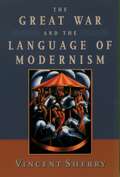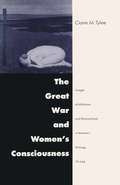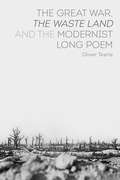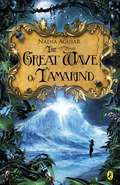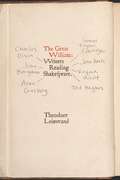- Table View
- List View
The Great War and the Language of Modernism
by Vincent SherryWith the expressions "Lost Generation" and "The Men of 1914," the major authors of modernism designated the overwhelming effect the First World War exerted on their era. Literary critics have long employed the same phrases in an attempt to place a radically experimental, specifically modernist writing in its formative, historical setting. What real basis did that Great War provide for the verbal inventiveness of modernist poetry and fiction? Does the literature we bring under this heading respond directly to that provocation, and, if so, what historical memories or revelations can be heard to stir in these words? Vincent Sherry reopens these long unanswered questions by focusing attention on the public culture of the English war. He reads the discourses through which the Liberal party constructed its cause, its Great Campaign. A breakdown in the established language of liberal modernity--the idioms of public reason and civic rationality--marked the sizable crisis this event represents in the mainstream traditions of post-Reformation Europe. If modernist writing characteristically attempts to challenge the standard values of Enlightenment rationalism, this study recovers the historical cultural setting of its most substantial and daring opportunity. And this moment was the occasion for great artistic innovations in the work of Virginia Woolf, T.S. Eliot, and Ezra Pound. Combining the records of political journalism and popular intellectual culture with abundant visual illustration, Vincent Sherry provides the framework for new interpretations of the major texts of Woolf, Eliot, and Pound. With its relocation of the verbal imagination of modernism in the context of the English war, The Great War and the Language of Modernism restores the historical content and depth of this literature, revealing its most daunting import.
The Great War and the Language of Modernism
by Vincent SherryWith the expressions "Lost Generation" and "The Men of 1914," the major authors of modernism designated the overwhelming effect the First World War exerted on their era. Literary critics have long employed the same phrases in an attempt to place a radically experimental, specifically modernist writing in its formative, historical setting. What real basis did that Great War provide for the verbal inventiveness of modernist poetry and fiction? Does the literature we bring under this heading respond directly to that provocation, and, if so, what historical memories or revelations can be heard to stir in these words? Vincent Sherry reopens these long unanswered questions by focusing attention on the public culture of the English war. He reads the discourses through which the Liberal party constructed its cause, its Great Campaign. A breakdown in the established language of liberal modernity--the idioms of public reason and civic rationality--marked the sizable crisis this event represents in the mainstream traditions of post-Reformation Europe. If modernist writing characteristically attempts to challenge the standard values of Enlightenment rationalism, this study recovers the historical cultural setting of its most substantial and daring opportunity. And this moment was the occasion for great artistic innovations in the work of Virginia Woolf, T.S. Eliot, and Ezra Pound. Combining the records of political journalism and popular intellectual culture with abundant visual illustration, Vincent Sherry provides the framework for new interpretations of the major texts of Woolf, Eliot, and Pound. With its relocation of the verbal imagination of modernism in the context of the English war, The Great War and the Language of Modernism restores the historical content and depth of this literature, revealing its most daunting import.
Great War and Women's Consciousness: Images of Militarism and Womanhood
by Claire M. TyleeThe literary memory of the Great War is dominated by the writings of Sassoon and Owen, Graves and Blunden. The voice is a male voice. This book is a study of what women wrote about militarism and world war 1
Great War Literature A-Level Notes on Strange Meeting - A Novel by Susan Hill (Great War Literature Study Guides)
by W. LawranceUseful in-depth summary/analysis of the novel Detailed notes on Character Analysis Examination of Themes Critical Comparisons with other First World War Literature Critical Analysis of certain aspects of the novel Coursework suggestions and advice to students.
Great War Modernisms and 'The New Age' Magazine (Historicizing Modernism)
by Paul JacksonThe literary magazine The New Age broughttogether a diverse set of intellectuals. Against the backdrop of the FirstWorld War, they chose to write about more than modernist art and aesthetics. Byclosely reading and contextualizing their contributions, Paul Jackson's studyengages with the political and philosophical responses of literary artists tomodernity. Jackson demonstrates the need to interpret modernism not merely as anaesthetic phenomenon,but inherently linked to politics and philosophy. Â By placing the writing of a canonical modernist, Wyndham Lewis, against afigure usually excluded from the modernist canon, H.G. Wells, Jackson examinesfurther a wartime modernism that embraced socialist and political views. Thisreinterpretation of modernism provides a historicised understanding of thepoliticised hopes of artists promoting revolutionary forms of cultural renewal.Considering modernist writers' relationship between politics,philosophy andaesthetics in the context of total war Jackson encourages newcultural-historical definitions of modernism. In addition this study providesthe first close analysis of cultural contributions from a leading wartimeLittle Magazine, tracing the radical modernist debates that developed in itspages.
Great War Modernisms and 'The New Age' Magazine: And The New Age Magazine (Historicizing Modernism)
by Paul JacksonThe literary magazine The New Age broughttogether a diverse set of intellectuals. Against the backdrop of the FirstWorld War, they chose to write about more than modernist art and aesthetics. Byclosely reading and contextualizing their contributions, Paul Jackson's studyengages with the political and philosophical responses of literary artists tomodernity. Jackson demonstrates the need to interpret modernism not merely as anaesthetic phenomenon,but inherently linked to politics and philosophy. By placing the writing of a canonical modernist, Wyndham Lewis, against afigure usually excluded from the modernist canon, H.G. Wells, Jackson examinesfurther a wartime modernism that embraced socialist and political views. Thisreinterpretation of modernism provides a historicised understanding of thepoliticised hopes of artists promoting revolutionary forms of cultural renewal.Considering modernist writers' relationship between politics,philosophy andaesthetics in the context of total war Jackson encourages newcultural-historical definitions of modernism. In addition this study providesthe first close analysis of cultural contributions from a leading wartimeLittle Magazine, tracing the radical modernist debates that developed in itspages.
Great War Modernists: D.H. Lawrence, H.D. and Richard Aldington (Historicizing Modernism)
by Lee M. JenkinsTaking 44 Mecklenburgh Square as the focal point and springboard for a critical group study of D.H. Lawrence, H.D. and Richard Aldington, this book offers a fresh perspective on the relationship of modernist biofiction and poetry to the literature of the First World War. A group that Perdita Schaffner described as 'another Bloomsbury set', the Mecklenburgh Square writers, like the Bloomsbury Group proper, 'lived in squares' and 'loved in triangles', in Dorothy Parker's famous formulation. Geographically adjacent, these sets intersected socially and, at points, in their aesthetics: both practiced innovative forms of what may broadly be defined as 'life writing'. But, demarcating the Mecklenburgh Square writers from the Bloomsbury Set, the former had its origins in the transatlantic avant-garde: Lawrence. H.D., Aldington (and John Cournos) were all associated with Imagism, the poetic movement which instantiated Anglo-American modernism. Considered as a pro-tem collective, these four poets, all of whom were also novelists and translators, contest the binaries that still obtain between modernist and First World War writing. This group study of Lawrence, H.D., Aldington and Cournos tracks the transition of Imagism from a pre-war mode to a war poetics which includes but is not confined to the trench lyric and it traces, in the transtextual relations between the Mecklenburgh Square novels, the traumatic imprint of the war on modernist life writing.
Great War Modernists: D.H. Lawrence, H.D. and Richard Aldington (Historicizing Modernism)
by Lee M. JenkinsTaking 44 Mecklenburgh Square as the focal point and springboard for a critical group study of D.H. Lawrence, H.D. and Richard Aldington, this book offers a fresh perspective on the relationship of modernist biofiction and poetry to the literature of the First World War. A group that Perdita Schaffner described as 'another Bloomsbury set', the Mecklenburgh Square writers, like the Bloomsbury Group proper, 'lived in squares' and 'loved in triangles', in Dorothy Parker's famous formulation. Geographically adjacent, these sets intersected socially and, at points, in their aesthetics: both practiced innovative forms of what may broadly be defined as 'life writing'. But, demarcating the Mecklenburgh Square writers from the Bloomsbury Set, the former had its origins in the transatlantic avant-garde: Lawrence. H.D., Aldington (and John Cournos) were all associated with Imagism, the poetic movement which instantiated Anglo-American modernism. Considered as a pro-tem collective, these four poets, all of whom were also novelists and translators, contest the binaries that still obtain between modernist and First World War writing. This group study of Lawrence, H.D., Aldington and Cournos tracks the transition of Imagism from a pre-war mode to a war poetics which includes but is not confined to the trench lyric and it traces, in the transtextual relations between the Mecklenburgh Square novels, the traumatic imprint of the war on modernist life writing.
Great War Prostheses in American Literature and Culture
by Aaron ShaheenDrawing on rehabilitation publications, novels by both famous and obscure American writers, and even the prosthetic masks of a classically trained sculptor, Great War Prostheses in American Literature and Culture addresses the ways in which prosthetic devices were designed, promoted, and depicted in America in the years during and after the First World War. The war's mechanized weaponry ushered in an entirely new relationship between organic bodies and the technology that could both cause, and attempt to remedy, hideous injuries. Such a relationship was also evident in the realm of prosthetic development, which by the second decade of the twentieth century promoted the belief that a prosthesis should be a spiritual extension of the person who possessed it. This spiritualized vision of prostheses proved particularly resonant in American postwar culture. Relying on some of the most recent developments in literary and disability studies, the book's six chapters explain how a prosthesis's spiritual promise was largely dependent on its ability to nullify an injury and help an amputee renew or even improve upon his prewar life. But if it proved too cumbersome, obtrusive, or painful, the device had the long-lasting power to efface or distort his 'spirit' or personality.
Great War Prostheses in American Literature and Culture
by Aaron ShaheenDrawing on rehabilitation publications, novels by both famous and obscure American writers, and even the prosthetic masks of a classically trained sculptor, Great War Prostheses in American Literature and Culture addresses the ways in which prosthetic devices were designed, promoted, and depicted in America in the years during and after the First World War. The war's mechanized weaponry ushered in an entirely new relationship between organic bodies and the technology that could both cause, and attempt to remedy, hideous injuries. Such a relationship was also evident in the realm of prosthetic development, which by the second decade of the twentieth century promoted the belief that a prosthesis should be a spiritual extension of the person who possessed it. This spiritualized vision of prostheses proved particularly resonant in American postwar culture. Relying on some of the most recent developments in literary and disability studies, the book's six chapters explain how a prosthesis's spiritual promise was largely dependent on its ability to nullify an injury and help an amputee renew or even improve upon his prewar life. But if it proved too cumbersome, obtrusive, or painful, the device had the long-lasting power to efface or distort his 'spirit' or personality.
The Great War, The Waste Land and the Modernist Long Poem
by Oliver TearleThe Great War, The Waste Land and the Modernist Long Poem explores how cultural responses to the trauma of the First World War found expression in the form of the modernist long poem. Beginning with T.S. Eliot's The Waste Land, Oliver Tearle reads that most famous example of the genre in comparison with lesser known long poems, such as Hope Mirrlees's Paris: A Poem, Richard Aldington's A Fool I' the Forest and Nancy Cunard's Parallax. As well as presenting a new history of this neglected genre, the book examines the ways in which the modernist long poem represented the seminal literary form for grappling with the crises of European modernity in the wake of World War I.
The Great War, The Waste Land and the Modernist Long Poem
by Oliver TearleThe Great War, The Waste Land and the Modernist Long Poem explores how cultural responses to the trauma of the First World War found expression in the form of the modernist long poem. Beginning with T.S. Eliot's The Waste Land, Oliver Tearle reads that most famous example of the genre in comparison with lesser known long poems, such as Hope Mirrlees's Paris: A Poem, Richard Aldington's A Fool I' the Forest and Nancy Cunard's Parallax. As well as presenting a new history of this neglected genre, the book examines the ways in which the modernist long poem represented the seminal literary form for grappling with the crises of European modernity in the wake of World War I.
The Great Wave of Tamarind (The\book Of Tamarind Ser. #3)
by Nadia AguiarFor Penny, the beautiful island of Tamarind is no more than a half-remembered story from years ago. But one mysterious night, with only a loyal green parrot for company, Penny is flung headfirst into adventure on its magical shores...Penny finds herself in unfamiliar Kana, in the midst of preparations for a magnificent competition - the Bloom Festival. But behind the excitement, something menacing lurks. The idyllic landscape of Tamarind is pocked with strange whorls, and an unnerving presence strikes fear into the hearts of Kana's bravest. From deepest water to darkest jungle, the trials of the Bloom Festival will test strength, courage, and friendships, and sacrifices will have to be made...Can Penny and her new friends beat all the odds and save Kana from ruin?
The Great When: A Long London Novel
by Alan MooreA propulsive tour through a fantastical London, where history and myth collide, murder stalks the streets and the mundane becomes very magical indeed…The year is 1949, the city London. Amidst the smog of the capital is Dennis Knuckleyard, a hapless eighteen-year-old employed by a second-hand bookshop. One day, on an errand to acquire books for sale, Dennis discovers a novel that simply does not exist. It is a fictitious book, a figment from another novel. Yet it is physically there in his hands. How?Dennis has stumbled on a book from the Great When, a magical version of London beyond time and space, where reality blurs with fiction and concepts such as Crime and Poetry are incarnated as wondrous, terrible beings. But this other, magical London must remain a secret: if Dennis cannot find a way to return this book to where it belongs, he risks bizarre and disastrous repercussions, such as his body being turned inside out (or worse).So begins a journey delving deep into the city's occult underbelly and tarrying with an eccentric cast of sorcerers, gangsters, and murderers – some from legend, some all too real, and all with plans of their own. Soon Dennis finds himself at the centre of an explosive series of events that may alter and endanger both Londons forever.Thrilling, lyrical and sparkling with dark humour, The Great When is the first book in a new series by Sunday Times-bestseller and icon, Alan Moore.'A breathless time-travelling classic. Savage, humane, comic, terrifying' Iain Sinclair'Brilliant and so powerfully imaginative' Adam Curtis'A weird book and a complete joy' Mariana Enríquez'A masterful step from one of our very best, uncompromising storytellers; Moore peels back the layers of London and reveals not only the history we know, but the histories that could have been, and, underneath it all, both the dark and beautiful truths about who we are as a nation.' Heather Parry
The Great When: A Long London Novel
by Alan MooreA propulsive tour through a fantastical London, where history and myth collide, murder stalks the streets and the mundane becomes very magical indeed…The year is 1949, the city London. Amidst the smog of the capital is Dennis Knuckleyard, a hapless eighteen-year-old employed by a second-hand bookshop. One day, on an errand to acquire books for sale, Dennis discovers a novel that simply does not exist. It is a fictitious book, a figment from another novel. Yet it is physically there in his hands. How?Dennis has stumbled on a book from the Great When, a magical version of London beyond time and space, where reality blurs with fiction and concepts such as Crime and Poetry are incarnated as wondrous, terrible beings. But this other, magical London must remain a secret: if Dennis cannot find a way to return this book to where it belongs, he risks bizarre and disastrous repercussions, such as his body being turned inside out (or worse).So begins a journey delving deep into the city's occult underbelly and tarrying with an eccentric cast of sorcerers, gangsters, and murderers – some from legend, some all too real, and all with plans of their own. Soon Dennis finds himself at the centre of an explosive series of events that may alter and endanger both Londons forever.Thrilling, lyrical and sparkling with dark humour, The Great When is the first book in a new series by Sunday Times-bestseller and icon, Alan Moore.'A breathless time-travelling classic. Savage, humane, comic, terrifying' Iain Sinclair'Brilliant and so powerfully imaginative' Adam Curtis'A weird book and a complete joy' Mariana Enríquez'A masterful step from one of our very best, uncompromising storytellers; Moore peels back the layers of London and reveals not only the history we know, but the histories that could have been, and, underneath it all, both the dark and beautiful truths about who we are as a nation.' Heather Parry
The Great When: A Long London Novel (Long London)
by Alan MooreFrom the New York Times bestselling author and legendary storyteller Alan Moore, the first book in an enthralling new fantasy series about murder, magic, and madness in post-WWII London. The year is 1949, the city London. Amidst the smog of the capital stumbles Dennis Knuckleyard, a hapless eighteen year-old employed by a second-hand bookshop. One day, on an errand to acquire books for sale, Dennis discovers a novel that simply does not exist. It is a fictitious book, a figment from another novel. Yet it is physically there in his hands. How? Dennis has stumbled on a book from the Great When, a magical version of London beyond time and space, where reality blurs with fiction and concepts such as Crime and Poetry are incarnated as wondrous, terrible beings. But this other, magical London must remain a secret: if Dennis cannot find a way to return this book to where it belongs, he risks repercussions, such as his body being turned inside out (or worse). So begins a journey delving deep into the city's occult underbelly and tarrying with an eccentric cast of sorcerers, gangsters, and murderers – some from legend, some all too real, and all with plans of their own. Soon Dennis finds himself at the centre of an explosive series of events that may alter and endanger both Londons forever...Named a Most Anticipated Novel by Associated Press, NPR.org, Literary Hub, Reactor, Publishers Weekly, and Parade.
The Great Wide Open
by Douglas Kennedy“All families are secret societies. Realms of intrigue and internal warfare, governed by their own rules . . .”It’s 1980s New York. Heady, excessive times. Alice Burns - a young book editor - is deep into a manuscript about the morass of family life. The observations resonates, perhaps because she has just watched her own family implode.As she reads she wonders: When did the sadness start? And could it be that unhappiness is a choice?Thus begins a great American epic which follows Alice as she navigates high school bullying, first love and sexism at an elite college, a spell in 1970's Ireland, and a tragedy that sends her stateside as the US embraces a cowboy actor named Reagan. But it is also the tale of her endlessly complex parents and brothers; how their destinies are written by the lies they tell themselves and others. The Great Wide Open is an immensely ambitious and compulsive saga; a novel which will speak volumes to anyone who has marvelled at that pain that can only be caused by family itself.
The Great William: Writers Reading Shakespeare
by Theodore LeinwandThe Great William is the first book to explore how seven renowned writers—Samuel Taylor Coleridge, John Keats, Virginia Woolf, Charles Olson, John Berryman, Allen Ginsberg, and Ted Hughes—wrestled with Shakespeare in the very moments when they were reading his work. What emerges is a constellation of remarkable intellectual and emotional encounters. Theodore Leinwand builds impressively detailed accounts of these writers’ experiences through their marginalia, lectures, letters, journals, and reading notes. We learn why Woolf associated reading Shakespeare with her brother Thoby, and what Ginsberg meant when referring to the mouth feel of Shakespeare’s verse. From Hughes’s attempts to find a “skeleton key” to all of Shakespeare’s plays to Berryman’s tormented efforts to edit King Lear, Leinwand reveals the palpable energy and conviction with which these seven writers engaged with Shakespeare, their moments of utter self-confidence and profound vexation. In uncovering these intense public and private reactions, The Great William connects major writers’ hitherto unremarked scenes of reading Shakespeare with our own.
The Great William: Writers Reading Shakespeare
by Theodore LeinwandThe Great William is the first book to explore how seven renowned writers—Samuel Taylor Coleridge, John Keats, Virginia Woolf, Charles Olson, John Berryman, Allen Ginsberg, and Ted Hughes—wrestled with Shakespeare in the very moments when they were reading his work. What emerges is a constellation of remarkable intellectual and emotional encounters. Theodore Leinwand builds impressively detailed accounts of these writers’ experiences through their marginalia, lectures, letters, journals, and reading notes. We learn why Woolf associated reading Shakespeare with her brother Thoby, and what Ginsberg meant when referring to the mouth feel of Shakespeare’s verse. From Hughes’s attempts to find a “skeleton key” to all of Shakespeare’s plays to Berryman’s tormented efforts to edit King Lear, Leinwand reveals the palpable energy and conviction with which these seven writers engaged with Shakespeare, their moments of utter self-confidence and profound vexation. In uncovering these intense public and private reactions, The Great William connects major writers’ hitherto unremarked scenes of reading Shakespeare with our own.
The Great William: Writers Reading Shakespeare
by Theodore LeinwandThe Great William is the first book to explore how seven renowned writers—Samuel Taylor Coleridge, John Keats, Virginia Woolf, Charles Olson, John Berryman, Allen Ginsberg, and Ted Hughes—wrestled with Shakespeare in the very moments when they were reading his work. What emerges is a constellation of remarkable intellectual and emotional encounters. Theodore Leinwand builds impressively detailed accounts of these writers’ experiences through their marginalia, lectures, letters, journals, and reading notes. We learn why Woolf associated reading Shakespeare with her brother Thoby, and what Ginsberg meant when referring to the mouth feel of Shakespeare’s verse. From Hughes’s attempts to find a “skeleton key” to all of Shakespeare’s plays to Berryman’s tormented efforts to edit King Lear, Leinwand reveals the palpable energy and conviction with which these seven writers engaged with Shakespeare, their moments of utter self-confidence and profound vexation. In uncovering these intense public and private reactions, The Great William connects major writers’ hitherto unremarked scenes of reading Shakespeare with our own.
The Great William: Writers Reading Shakespeare
by Theodore LeinwandThe Great William is the first book to explore how seven renowned writers—Samuel Taylor Coleridge, John Keats, Virginia Woolf, Charles Olson, John Berryman, Allen Ginsberg, and Ted Hughes—wrestled with Shakespeare in the very moments when they were reading his work. What emerges is a constellation of remarkable intellectual and emotional encounters. Theodore Leinwand builds impressively detailed accounts of these writers’ experiences through their marginalia, lectures, letters, journals, and reading notes. We learn why Woolf associated reading Shakespeare with her brother Thoby, and what Ginsberg meant when referring to the mouth feel of Shakespeare’s verse. From Hughes’s attempts to find a “skeleton key” to all of Shakespeare’s plays to Berryman’s tormented efforts to edit King Lear, Leinwand reveals the palpable energy and conviction with which these seven writers engaged with Shakespeare, their moments of utter self-confidence and profound vexation. In uncovering these intense public and private reactions, The Great William connects major writers’ hitherto unremarked scenes of reading Shakespeare with our own.
The Great William: Writers Reading Shakespeare
by Theodore LeinwandThe Great William is the first book to explore how seven renowned writers—Samuel Taylor Coleridge, John Keats, Virginia Woolf, Charles Olson, John Berryman, Allen Ginsberg, and Ted Hughes—wrestled with Shakespeare in the very moments when they were reading his work. What emerges is a constellation of remarkable intellectual and emotional encounters. Theodore Leinwand builds impressively detailed accounts of these writers’ experiences through their marginalia, lectures, letters, journals, and reading notes. We learn why Woolf associated reading Shakespeare with her brother Thoby, and what Ginsberg meant when referring to the mouth feel of Shakespeare’s verse. From Hughes’s attempts to find a “skeleton key” to all of Shakespeare’s plays to Berryman’s tormented efforts to edit King Lear, Leinwand reveals the palpable energy and conviction with which these seven writers engaged with Shakespeare, their moments of utter self-confidence and profound vexation. In uncovering these intense public and private reactions, The Great William connects major writers’ hitherto unremarked scenes of reading Shakespeare with our own.
The Great William: Writers Reading Shakespeare
by Theodore LeinwandThe Great William is the first book to explore how seven renowned writers—Samuel Taylor Coleridge, John Keats, Virginia Woolf, Charles Olson, John Berryman, Allen Ginsberg, and Ted Hughes—wrestled with Shakespeare in the very moments when they were reading his work. What emerges is a constellation of remarkable intellectual and emotional encounters. Theodore Leinwand builds impressively detailed accounts of these writers’ experiences through their marginalia, lectures, letters, journals, and reading notes. We learn why Woolf associated reading Shakespeare with her brother Thoby, and what Ginsberg meant when referring to the mouth feel of Shakespeare’s verse. From Hughes’s attempts to find a “skeleton key” to all of Shakespeare’s plays to Berryman’s tormented efforts to edit King Lear, Leinwand reveals the palpable energy and conviction with which these seven writers engaged with Shakespeare, their moments of utter self-confidence and profound vexation. In uncovering these intense public and private reactions, The Great William connects major writers’ hitherto unremarked scenes of reading Shakespeare with our own.
The Great Winglebury Duel (Penguin Little Black Classics)
by Charles Dickens'Desperate-minded villain!'Two of Dickens' hilarious early stories from Sketches by Boz: 'The Great Winglebury Duel' and 'Bloomsbury Christening'Introducing Little Black Classics: 80 books for Penguin's 80th birthday. Little Black Classics celebrate the huge range and diversity of Penguin Classics, with books from around the world and across many centuries. They take us from a balloon ride over Victorian London to a garden of blossom in Japan, from Tierra del Fuego to 16th century California and the Russian steppe. Here are stories lyrical and savage; poems epic and intimate; essays satirical and inspirational; and ideas that have shaped the lives of millions.Charles Dickens (1812-1870). All Dickens' novels and other major works are available in Penguin Classics.
